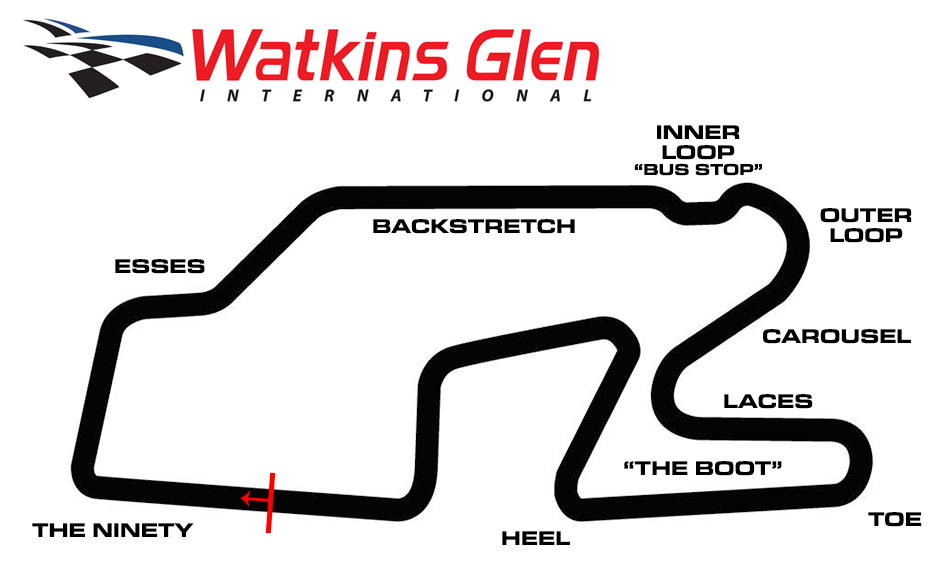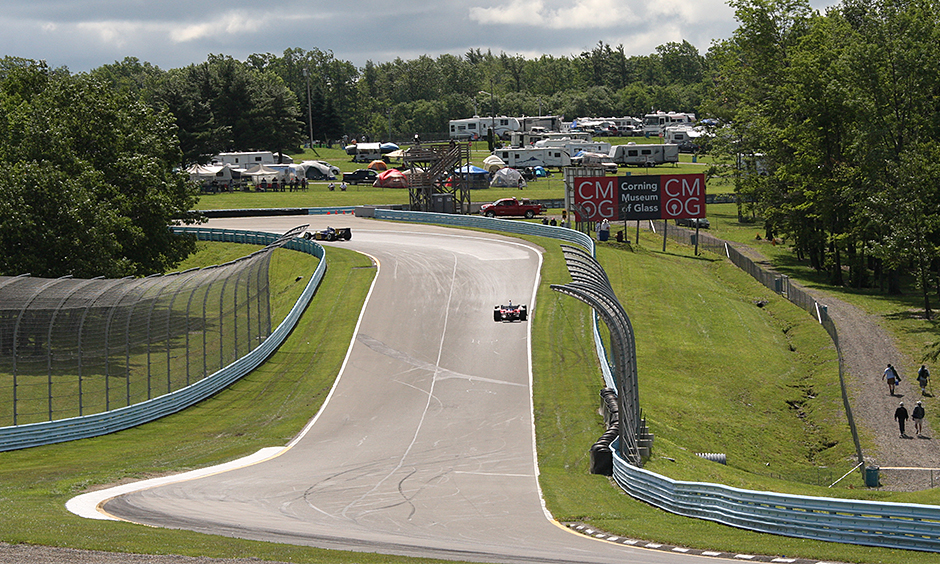Open-wheel racing enjoys storied history at The Glen
SEP 01, 2016
This weekend, the Verizon IndyCar Series attacks the blindingly fast, billiard-table-smooth ribbon of road that is Watkins Glen International, one of the premier natural terrain race courses in North America.
The INDYCAR Grand Prix at The Glen marks just the 10th time Indy cars are visiting the 60-year-old circuit, but open-wheel racing is etched in the history of motor racing in the Finger Lakes region of New York State, and its very presence played a major role in launching the circuit into legendary status.
The first motor race in Watkins Glen was contested in October 1948 on the public roads of the hamlet, the first road race in the United States following World War II. The original 6.6-mile circuit started in front of the Schuyler County Courthouse and snaked west around Watkins Glen State Park before reverting back east and north up Highway 409, streaming back to the courthouse on North Franklin Street.
A move after the 1952 race saw a new 4.6-mile circuit used five miles west of the town, with a 2.3-mile permanent course erected on the same site in 1956. Half a decade later, open-wheel racing made its official debut in New York State when Formula One held the first of 20 United States Grands Prix at Watkins Glen. Race day crowds, often cresting around 100,000 people, crammed the facility.
The 1971 grand prix saw a massive reconfiguration to the track, which set the footprint for the course that remains today. The popular reconfiguration added three turns, a new location for the start/finish line and pit lane, and a mile of new racetrack, including a southern portion of the alteration which became affectionately known as “The Boot” (see track map below).
The term “British Invasion” is usually attributed to the pop culture sensation that swept across the Atlantic in the 1960s, but the phrase could also be applied the early grands prix at The Glen. British racers Innes Ireland, Jim Clark, Graham Hill, Sir Jackie Stewart and James Hunt claimed 11 of the 20 Formula One wins at The Glen, including the first eight from 1961-68.
Formula One saw its era at The Glen come to a close in 1980, as the track’s main event transitioned to American open-wheel racing with the introduction of an Indy car race in 1979. The allure of the sport was spurred by captivating drivers, mind-boggling speed and rampant technological innovations.
One of the most fascinating of those drivers of the era, both on and off the track, Bobby Unser, turned out to be the most successful driver of that early Indy car era, winning two of the three races held under CART sanction at Watkins Glen from 1979-81. Unser, a three-time Indianapolis 500 winner, competed in the 1968 F1 race for BRM at Watkins Glen, but the New Mexico resident found a particular thrill a decade after his lone Formula One start.
“I liked all the racing at Watkins Glen,” said Unser, “but the Indy cars were my favorite. I can’t help it, but that was just my life, you know.”
When Indy cars first raced at The Glen, the long back straightaway, preceded by the high-speed complex of Turns 2-4 known as “the Esses,” went uninterrupted down to Turn 5, leading drivers from top speed into a fast downhill corner.
“Oh, that was really nice,” Unser, 82, said with a smile. “I mean really, really, really nice, because the turn at the end of that straightaway was awful fast because the back straightaway was just god-awful fast, and (the turn) had a little banking to it, so you could go into it fast. If you got into the turn really fast, really hard, and you were in the right groove, boy, you could just wail through that turn.”
Turn 5 was extremely dangerous due to the tremendous entrance speed, and was later slowed by the implementation of the “Inner Loop” bus stop chicane in 1992.
To Unser, corners like Turn 5 are part of what made Watkins Glen the track drivers yearned to race, and why it remains one of the crown jewels of American motor racing.
“It’s a race driver’s racetrack,” Unser said. “It’s not a lazy man’s racetrack at all. You had to work your butt off all the time at that track, and I think that that’s good. I think that makes racing better, more exciting for the fans, definitely more exciting for the drivers.”
Part of what defines the lore of Watkins Glen is that the track often writes the story. But on the rare occasion, it was the driver who wrote the script.
Perhaps no more distinctive of such occasions occurred in 2009, during the second stint of Indy car racing at The Glen (2005-2010), and still serves as one of the most prominent David-and-Goliath stories in motor racing.
Smack dab in the middle of a 2009 Verizon IndyCar Series season dominated by “super teams” Chip Ganassi Racing and Team Penske, the series’ visit to Watkins Glen was historic for a different kind of dominance. Justin Wilson led 49 of 60 laps to score the first race win in the 25-year history of the humbly-run Dale Coyne Racing.
“Justin did a great job that weekend,” team owner Coyne said. “We came pretty close to winning the first race that year in (St. Petersburg, Florida) when he made a mistake on a restart, so we reminded him of that mistake and he took off plenty early on that last restart (at Watkins Glen). It was nice to come around and win, with all those red cars (Ganassi and Penske) behind him.”
With the 10th running of Indy cars at Watkins Glen International this weekend, the INDYCAR Grand Prix at The Glen serves as a chance to add another chapter to the circuit’s deep and broad open-wheel racing legacy.
INDYCAR Grand Prix at The Glen
- Race 15 of 16 in the Verizon IndyCar Series season. There have been nine previous Indy car races at Watkins Glen International, from 1979-81 and 2005-10. Chip Ganassi Racing’s Scott Dixon has three wins at the track, the most of any Indy car driver.
- Race distance: 60 laps / 202.2 miles
- Track length: 3.37-mile, 11-turn permanent road course
- Track record: Ryan Briscoe 1 minute, 28.1322 seconds (137.657 mph), set in 2009 qualifying
- Weekend Firestone tire allotment: eight sets primary, three sets alternate (teams may earn an additional primary set by completing five laps on a set of tires within the first 20 minutes of green-flag time in Friday’s first practice session)
- Tickets and event information: www.theglen.com
- Twitter: @WGI, #INDYCARGP, @IndyCar, #IndyCar, #INDYRIVALS
- TV: NBCSN will telecast both of Friday’s practices live (11 a.m.-noon and 3:30-5:30 p.m. ET), Saturday’s Verizon P1 Award qualifying on a same-day delay (6 p.m.) and Sunday’s race live (2 p.m.).
- Radio: Advance Auto Parts INDYCAR Radio Network coverage of practice sessions is available on IndyCar.com, IndyCarRadio.com and the INDYCAR Mobile app. Qualifying coverage is available at those locations and on Sirius 212 and XM 209. The race can be heard on all the aforementioned locations as well as network affiliates.
- Video streaming: Saturday morning’s practice (11-11:45 a.m. ET) and Sunday morning’s warmup (10:30-11 a.m.) will stream live on RaceControl.IndyCar.com, including live timing and scoring and Advance Auto Parts INDYCAR Radio Network audio.
- strong>Fantasy league: The #INDYRIVALS Fantasy Challenge driven by Firestone allows fans to become a virtual Verizon IndyCar Series team owner by fielding a four-driver lineup for each race. Prizes are awarded following each event. Sign up at fantasy.indycar.com.























